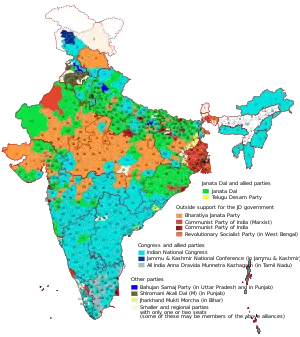Premiership of Vishwanath Pratap Singh
Vishwanath Pratap Singh held office for slightly less than a year, from 2 December 1989 to 10 November 1990. After state legislative elections in March 1990, Singh's governing coalition achieved control of both houses of India's parliament. Singh becomes the 8th Prime Minister of India, after the loss of Rajiv Gandhi in the 1989 Indian general election. Singh's newly formed National Front (India) won 143 seats in the Lok Sabha and was supported by Bharatiya Janata Party from outside.
.jpg.webp) | |||||
| Premiership of Lal Bahadur Shastri 1989 – 1990[1] | |||||
President | |||||
|---|---|---|---|---|---|
Vice President | |||||
| Cabinet | V. P. Singh ministry | ||||
| Party | Janata Dal | ||||
| Election | 1989 Indian general election | ||||
| Seat | Fatehpur (Lok Sabha constituency) | ||||
| |||||
| Official website Archived website Library website | |||||
Under his premiership there were made many controversial acts such as Mandal commission, which lead to a nation-wide protests and also social empowerment act like SC and ST Act, 1989. The exodus of Kashmiri Hindus was also a turning effect for his voting side. There was also a tussle between him and Reliance Industries.
His tenure ended on 10 November 1990, after Bharatiya Janata Party extended their support after stoppage of Ram Rath Yatra and arrest of party president, L. K. Advani. Chandra Shekhar immediately seized the moment and left the Janata Dal with several of his own supporters (including Devi Lal, Janeshwar Mishra, HD Deve Gowda, Maneka Gandhi, Ashoke Kumar Sen, Subodh Kant Sahay, Om Prakash Chautala, Hukam Singh, Chimanbhai Patel, Mulayam Singh Yadav, Yashwant Sinha, VC Shukla, and Sanjay Singh) to form the Samajwadi Janata Party/Janata Dal (Socialist). Although Chandra Shekhar had a mere 64 MPs, Rajiv Gandhi the leader of the Opposition, agreed to support him on the floor of the House; so he won a confidence motion and was sworn in as Prime Minister.
Taking the office

The 1989 Indian general elections were held because the previous Lok Sabha has been in power for five years, and the constitution allowed for new elections. Even though Rajiv Gandhi had won the last election by a landslide, this election saw him trying to fight off scandals that had marred his administration.[lower-alpha 1]
The Bofors scandal, rising terrorism in Punjab, the civil war between LTTE and Sri Lankan government were just some of the problems that stared at Rajiv's government.[lower-alpha 2] Singh was Rajiv's biggest critic was, who had held the portfolios of the finance ministry and the defense ministry in the government.[2]
But Singh was soon sacked from the Cabinet and he then resigned from his memberships in the Congress and the Lok Sabha. He formed the Jan Morcha with Arun Nehru and Arif Mohammad Khan and re-entered the Lok Sabha from Allahabad. Witnessing V P Singh's meteoric rise on the national stage, Rajiv tried to counter him with another prominent Rajput stalwart Satyendra Narain Singh but failed eventually.[3]
Singh, who was the head of the Janata Dal, was chosen leader of the National Front government.[4] And on 26 November he sworn the position.
Timeline
- 26 November 1989 - Singh's coalition of parties won 143 seats and was supported by Bharatiya Janata Party.
- 2 December 1989 - Singh swore as the 8th Prime Minister of India.[5]
- 8 December 1989 - 1989 kidnapping of Rubaiya Sayeed by Kashmiri militants.[6]
- 13 December 1989 - Release of 5 terrorists of Jammu Kashmir Liberation Front.[7]
- 16 December 1989 - Passing of Sixty-second Amendment of the Constitution of India in Lok Sabha.[8]
- 29 December 1989 - Passing of Scheduled Caste and Scheduled Tribe (Prevention of Atrocities) Act, 1989.[9]
- 29 July 1990 - Implementation of Mandal Commission.[10]
- August 1990 - Mandal Commission protests of 1990 all over the nation.[11][12]
- 19 September 1990 - Self-immolation of Rajiv Goswami.[13]
- 21 January 1990 - 13 February 1990 - Insurgency in Kashmir on Hindus increased leading to mass exodus.[14]
- 12 September 1990 - Starting of Ram Rath Yatra by L. K. Advani.[15]
- 23 October 1990 - Arrest of L. K. Advani on order of Singh.[16]
- 30 October 1990 - Anti-Singh movement in BJP.[17]
- 7 November 1990 - Resignation of Singh after no-confidence with a vote of 356 to 151.[18]
Premiership
Notes
- 1989 elections were considered as a lucky charm for the Singh in the politics on defeating the Rajiv Gandhi.
- After the Bofors scandal, Singh one of the biggest mates of Rajiv Gandhi became his biggest critic.(Mustafa, p. 78)
Sources
- Hewitt, 2007 & p-89.
- November 30, Uttam Sengupta; November 30, 1989 ISSUE DATE:; November 11, 1989UPDATED:; Ist, 2013 12:15. "Elections 1989: Congress(I) faces prospect of being routed in Bihar". India Today. Retrieved 23 December 2020.CS1 maint: extra punctuation (link) CS1 maint: numeric names: authors list (link)
- Gupta, U. N. (2003). Indian Parliamentary Democracy. Atlantic Publishers & Dist. p. 125. ISBN 978-81-269-0193-7.
- Saksena, N. S. (1993). India, Towards Anarchy, 1967-1992. Abhinav Publications. ISBN 978-81-7017-296-3.
- Tully, Mark (3 December 2008). "Obituary: VP Singh". the Guardian. Retrieved 23 December 2020.
- Feb 8, PTI /; 2004; Ist, 22:42. "14 yrs down, JKLF admits Rubaiya kidnap | India News - Times of India". The Times of India. Archived from the original on 9 January 2018. Retrieved 23 December 2020.CS1 maint: numeric names: authors list (link)
- Crossette, Barbara; Times, Special To the New York (14 December 1989). "ABDUCTED WOMAN FREED IN KASHMIR (Published 1989)". The New York Times. ISSN 0362-4331. Archived from the original on 25 June 2018. Retrieved 23 December 2020.
- "The Constitution of India (1949)" (PDF). Lok Sabha Secretariat. 1 March 2013. p. 1091. Archived (PDF) from the original on 3 December 2013. Retrieved 23 December 2020.
- "Supreme Court: SC/ST Amendment Act Constitutionally Valid, No Preliminary Enquiry for FIR". The Wire. Archived from the original on 3 August 2020. Retrieved 23 December 2020.
- Sharma, Pawan Kumar; Parthi, Komila (1 August 2016). "Reproductive health services in Punjab: Evidence of access for Scheduled Castes and non-Scheduled Castes:". Social Change. doi:10.1177/004908570403400204. ISSN 0049-0857. S2CID 146674412.
- Gehlot, N. S. (1998). Current Trends in Indian Politics. Deep & Deep Publications. ISBN 978-81-7100-798-1.
- Mustafa, p. (intro.).
- "The Tribune, Chandigarh, India - Main News". www.tribuneindia.com. Retrieved 23 December 2020.
- Metcalf, Barbara; Metcalf, Thomas R. (2006), A Concise History of Modern India (Cambridge Concise Histories), Cambridge and New York: Cambridge University Press. Pp. xxxiii, 372, ISBN 978-0-521-68225-1
- Jaffrelot, Christophe (2009). "The Hindu nationalist reinterpretation of pilgrimage in India: the limits of Yatra politics". Nations and Nationalism. 15 (1): 1–19. doi:10.1111/j.1469-8129.2009.00364.x. ISSN 1469-8129.
- Hewitt, p. 76.
- Crossette, Barbara; Times, Special To the New York (30 October 1990). "INDIA READY TO BAR HINDU MOVE TODAY (Published 1990)". The New York Times. ISSN 0362-4331. Retrieved 23 December 2020.
- Following his opposition to the Ram Rath Yatra, the BJP withdrew its support for the National Front, and his government lost the vote of no-confidence. Singh resigned on 7 November 1990. His prime ministerial tenure lasted for 343 days.(Mustafa, p. i-iii)
Bibliography
- Mustafa, Seema (1995). The Lonely Prophet: V.P. Singh, a Political Biography. University of Michigan, Ann Arbor, Michigan: SAGE Publishing. ISBN 8122408095. OCLC 33664491.
- Hewitt, Vernon (2007). Political Mobilisation and Democracy in India(States of Emergency). Taylor & Francis. ISBN 9781134097623.
External links
- Premiership of Vishwanath Pratap Singh at the Encyclopædia Britannica
- "Archived copy" (PDF). Archived from the original (PDF) on 18 July 2014. Retrieved 25 May 2014.CS1 maint: archived copy as title (link)
